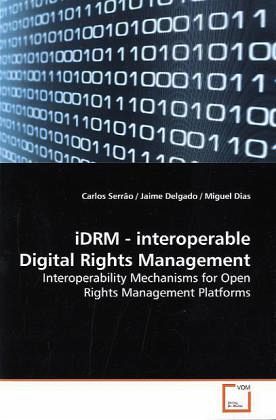
iDRM - interoperable Digital Rights Management
Interoperability Mechanisms for Open Rights Management Platforms
Versandkostenfrei!
Versandfertig in 6-10 Tagen
52,99 €
inkl. MwSt.

PAYBACK Punkte
26 °P sammeln!
Technology is raising important challenges in theIntellectual Property (IP) field in general. The technology thathas made possible the access to content in a ubiquitous manner,available to everyone in a simple and fast way, is also the mainresponsible for the challenges affecting the digital content IP of our days.Technological solutions and legal frameworks werecreated to meet these new challenges. From the technological point ofview, Rights Management Systems (RMS) and Copy Protection Systems(CPS) have been developed and deployed to try to cope with them.At first, they seemed to work however...
Technology is raising important challenges in the
Intellectual
Property (IP) field in general. The technology that
has made possible
the access to content in a ubiquitous manner,
available to everyone
in a simple and fast way, is also the main
responsible for the
challenges affecting the digital content IP of our days.
Technological solutions and legal frameworks were
created to meet
these new challenges. From the technological point of
view, Rights
Management Systems (RMS) and Copy Protection Systems
(CPS) have
been developed and deployed to try to cope with them.
At first, they
seemed to work however, their closed and
non-interoperable nature
and a growing number of wrong strategic business
decisions, soon
lead to a strong opposition. One of the strongest
negative points is
the lack of rights management interoperability.
This book addressed the RMS interoperability
problems, presenting
some possible mechanisms to improve the
interoperability between
the different existing and emerging open rights
management
platforms.
Intellectual
Property (IP) field in general. The technology that
has made possible
the access to content in a ubiquitous manner,
available to everyone
in a simple and fast way, is also the main
responsible for the
challenges affecting the digital content IP of our days.
Technological solutions and legal frameworks were
created to meet
these new challenges. From the technological point of
view, Rights
Management Systems (RMS) and Copy Protection Systems
(CPS) have
been developed and deployed to try to cope with them.
At first, they
seemed to work however, their closed and
non-interoperable nature
and a growing number of wrong strategic business
decisions, soon
lead to a strong opposition. One of the strongest
negative points is
the lack of rights management interoperability.
This book addressed the RMS interoperability
problems, presenting
some possible mechanisms to improve the
interoperability between
the different existing and emerging open rights
management
platforms.












